Experimental Observations on Impact Velocity and Entrapped Air for Standing Wave Impacts on Vertical Hydraulic Structures with Overhangs
Abstract
1. Introduction
1.1. Literature
1.2. Paper Aims
2. Laboratory Experiments
2.1. Experiment Description
2.2. Instrumentation
3. Impact Velocity
3.1. Theoretical Estimation
3.2. Impact Velocity without Overhangs
3.3. Impact Velocity with Overhangs
4. Entrapped Air Size Quantification
5. Conclusions
Author Contributions
Funding
Conflicts of Interest
References
- De Almeida, E.; Hofland, B. Validation of pressure-impulse theory for standing wave impact loading on vertical hydraulic structures with short overhangs. Coast. Eng. 2020, 159, 103702. [Google Scholar] [CrossRef]
- Bagnold, R.A. Wave-pressure research. Inst. Civ. Eng. 1939, 12, 202–226. [Google Scholar] [CrossRef]
- Minikin, R.R. Winds, Waves and Maritime Structures; Griffin: London, UK, 1950. [Google Scholar]
- Goda, Y. A new method of wave pressure calculation for the design of composite breakwater. In Proceedings of the Coastal Engineering Conference, Copenhagen, Denmark, 24–28 June 1974. [Google Scholar]
- Takahashi, S.; Tanimoto, K.; Shimosako, K. A Proposal of impulsive pressure coefficient for design of composite breakwaters. In Proceedings of the International Conference of Hydro-Technical Engineering for Port and Harbour Construction, Yokosuka, Japan, 19–21 October 1994. [Google Scholar]
- Mitsuyasu, H. Shock pressure of breaking wave. In Proceedings of the Coastal Engineering Conference, Orlando, FL, USA, 2–6 September 1996. [Google Scholar]
- Partenscky, H.W. Dynamic forces due to waves breaking at vertical coastal structures. In Proceedings of the Coastal Engineering Conference, Sol-Malaga, Spain, 20–25 June 1988. [Google Scholar]
- Oumeraci, H.; Kortenhaus, A.; Allsop, W.; de Groot, M.; Crouch, R.; Vrijling, H.; Voortman, H. Proverbs: Probabilistic Design Tools for Vertical Breakwaters; Balkema: Lisse, The Netherlands, 2001. [Google Scholar]
- Cuomo, G.; Allsop, W.; Bruce, T.; Pearson, J. Breaking wave loads at vertical seawalls and breakwaters. Coast. Eng. 2010, 57, 424–439. [Google Scholar] [CrossRef]
- Kisacik, D.; Troch, P.; Bogaert, P.V.; Caspeele, R. Investigation of uplift impact forces on a vertical wall with an overhanging horizontal cantilever slab. Coast. Eng. 2014, 90, 12–22. [Google Scholar] [CrossRef]
- Chen, X.; Hofland, B.; Altomare, C.; Suzuki, T.; Uijttewaal, W. Forces on a vertical wall on a dike crest due to overtopping flow. Coast. Eng. 2015, 95, 94–104. [Google Scholar] [CrossRef]
- Chen, X.; Hofland, B.; Uijttewaal, W. Maximum overtopping forces on a dike-mounted wall with a shallow foreshore. Coast. Eng. 2016, 116, 89–102. [Google Scholar] [CrossRef]
- McConnell, K.; Allsop, W.; Cruickshank, I. Piers, Jetties and Related Structures Exposed to Waves: Guidelines for Hydraulic Loadings; Thomas Telford Publishing: London, UK, 2004. [Google Scholar]
- Cuomo, G.; Tirindelli, M.; Allsop, W. Wave-in-deck loads on exposed jetties. Coast. Eng. 2007, 54, 657–679. [Google Scholar] [CrossRef]
- Seiffert, B.; Hayatdavoodi, M.; Ertekin, R.C. Experiments and computations of solitary-wave forces on a coastal-bridge deck. Part I: Flat Plate. Coast. Eng. 2014, 88, 194–209. [Google Scholar] [CrossRef]
- Hayatdavoodi, M.; Seiffert, B.; Ertekin, R.C. Experiments and computations of solitary-wave forces on a coastal-bridge deck. Part II: Deck with girders. Coast. Eng. 2014, 88, 210–228. [Google Scholar] [CrossRef]
- Dias, F.; Ghidaglia, J.M. Slamming: Recent Progress in the Evaluation of Impact Pressures. Annu. Rev. Fluid Mech. 2018, 50, 243–273. [Google Scholar] [CrossRef]
- Sonneville, B.; Hofland, B.; Mowinckel, A.; Paulsen, B. Wave impact loads on offshore gravity based structure. In Proceedings of the OMAE Conference, St. John’s, NL, Canada, 31 May–5 June 2015. [Google Scholar]
- Bogaert, H. An experimental investigation of sloshing impact physics in membrane LNG tanks on foating structures. Ph.D. Thesis, Delft University of Technology, Delft, The Netherlands, 2018. [Google Scholar]
- Ramkema, C. A model law for wave impacts on coastal structures. In Proceedings of the Coastal Engineering Conference, Hamburg, Germany, 27 August–3 September 1978. [Google Scholar]
- Castellino, M.; Sammarco, P.; Romano, A.; Martinelli, L.; Ruol, P.; Franco, L.; Girolamo, P.D. Large impulsive forces on recurved parapets under non-breaking waves. A numerical study. Coast. Eng. 2018, 136, 1–15. [Google Scholar] [CrossRef]
- Martinelli, L.; Ruol, P.; Volpato, M.; Favaretto, C.; Castellino, M.; Girolamo, P.D.; Franco, L.; Romano, A.; Sammarco, P. Experimental investigation on non-breaking wave forces and overtopping at the recurved parapets of vertical breakwaters. Coast. Eng. 2018, 141, 52–67. [Google Scholar] [CrossRef]
- de Almeida, E.; Hofland, B.; Jonkman, S. Wave impact pressure-impulse on vertical structures with overhangs. In Proceedings of the Coastal Structures Conference, Hannover, Germany, 30 September–2 October 2019. [Google Scholar]
- WL. Wave impacts on the gate in the Eastern Scheldt caisson. In Dutch: Golfklappen op de Schuif in de Oosterschelde-Caisson; Verslag M 1335 deel I; WL Delft Hydraulics (Presently Deltares): Delft, The Netherlands, 1977. [Google Scholar]
- WL. Wave impacts against concrete perforated gates. In Dutch: Golfklappen Tegen Betonnen Roosterschuiven; Verslag M 1381 deel II; WL Delft Hydraulics (Presently Deltares): Delft, The Netherlands, 1978. [Google Scholar]
- WL. Wave impacts: A piston model with compressible water. In Dutch: Golfklappen: Een Zuigermodel Met Samendrukbaar Water; Verslag M 1335 deel II; WL Delft Hydraulics (Presently Deltares): Delft, The Netherlands, 1979. [Google Scholar]
- WL. Wave impacts: A literature review and scale effects in model studies. In Dutch: Golfklappen: Een Literaturroverzicht en Schaaleffekten in Modelonderzoek; Verslag M 1335 deel III; WL Delft Hydraulics (Presently Deltares): Delft, The Netherlands, 1979. [Google Scholar]
- Hofland, B. Modeltesten Golfkrachten Spuisluizen Afsluitdijk; Meetrapport 1220263; Deltares: Delft, The Netherlands, 2015. [Google Scholar]
- Cooker, M.J.; Peregrine, D.H. A model for breaking wave impact pressures. In Proceedings of the Coastal Engineering Conference, Delft, The Netherlands, 2–6 July 1990. [Google Scholar]
- Cooker, M.J.; Peregrine, D.H. Pressure-impulse theory for liquid impact problems. J. Fluid Mech. 1995, 297, 193–214. [Google Scholar] [CrossRef]
- Wood, D.J.; Peregrine, D.H. Wave impact beneath a horizontal surface. In Proceedings of the Coastal Engineering Conference, Orlando, FL, USA, 2–6 September 1996. [Google Scholar]
- Peregrine, D.H.; Thais, L. The effect of entrained air in violent wave impacts. J. Fluid Mech. 1996, 325, 377–397. [Google Scholar] [CrossRef]
- Wood, D.J.; Peregrine, D.H.; Bruce, T. Study of wave impact against a wall with pressure-impulse theory. I: Trapped air. J. Waterw. Port Coast. Ocean. Eng. 2000, 126, 182–190. [Google Scholar] [CrossRef]
- Bredmose, H.; Peregrine, D.; Bullock, G. Violent breaking wave impacts. Part 2: Modelling the effect of air. J. Fluid Mech. 2009, 641, 389–430. [Google Scholar] [CrossRef]
- Peregrine, D.H. Water-wave impact on walls. Annu. Rev. Fluid Mech. 2003, 35, 23–43. [Google Scholar] [CrossRef]
- Sainflou, M. Essai sur les digues maritimes verticales. Ann. Des Ponts Chaussées 1928, 98, 5–48. [Google Scholar]
- Miche, M. Mouvement ondulatoire de la mer en profondeur constante ou decroissante. Ann. Des. Ponts Chaussées 1944, 121, 285–318. [Google Scholar]
- Tadjbakhsh, I.; Keller, J.B. Standing surface waves of finite amplitude. J. Fluid Mech. 1960, 8, 442–451. [Google Scholar] [CrossRef]
- Penney, W.G.; Price, A.T.; Martin, J.C.; Moyce, W.J.; Thornhill, C.K. Finite periodic stationary gravity waves in a perfect liquid. Philos. Trans. R. Soc. Lond. 1952, 244, 254–284. [Google Scholar]
- Goda, Y. Finite periodic stationary gravity waves in a perfect liquid. Coast. Eng. Jpn. 1967, 10, 1–11. [Google Scholar] [CrossRef]
- Jeng, D. Wave kinematics of partial reflection from a vertical wall. Ocean. Eng. 2002, 29, 1711–1724. [Google Scholar] [CrossRef]
- Teo, H. Wave pressures on a vertical wall due to short-crested waves: Fifth-order approximation. Ocean. Eng. 2003, 30, 2157–2166. [Google Scholar] [CrossRef]
- Hedges, T. Regions of validity of analytical wave theories. ICE Water Marit. Energy 1995, 112, 111–114. [Google Scholar] [CrossRef]
- Fenton, J.D. Wave Forces on Vertical Walls. J. Waterw. Port Coast. Ocean. Eng. 1985, 111, 693–718. [Google Scholar] [CrossRef]
- Bridges, T.J. Wave Forces on Vertical Walls. J. Waterw. Port Coast. Ocean. Eng. 1986, 29, 2819–2827. [Google Scholar]
- Romanczyk, W. Instability of nonlinear standing waves in front of a vertical wall. J. Fluids Struct. 2007, 23, 733–753. [Google Scholar] [CrossRef]
- Chen, X.; Hofland, B.; Molenaar, W.; Capel, A.; Gent, M.R.V. Use of impulses to determine the reaction force of a hydraulic structure with an overhang due to wave impact. Coast. Eng. 2019, 147, 75–88. [Google Scholar] [CrossRef]
- Tieleman, O.C.; Tsouvalas, A.; Hofland, B.; Jonkman, S.N. A three dimensional semi-analytical model for the prediction of gate vibrations. Mar. Struct. 2019, 65, 134–153. [Google Scholar] [CrossRef]
- Zelt, J.; Skjelbreia, J. Estimating Incident and Reflected Wave Fields Using an Arbitrary Number of Wave Gauges. In Proceedings of the Coastal Engineering Conference, Venice, Italy, 4–9 October 1992. [Google Scholar]

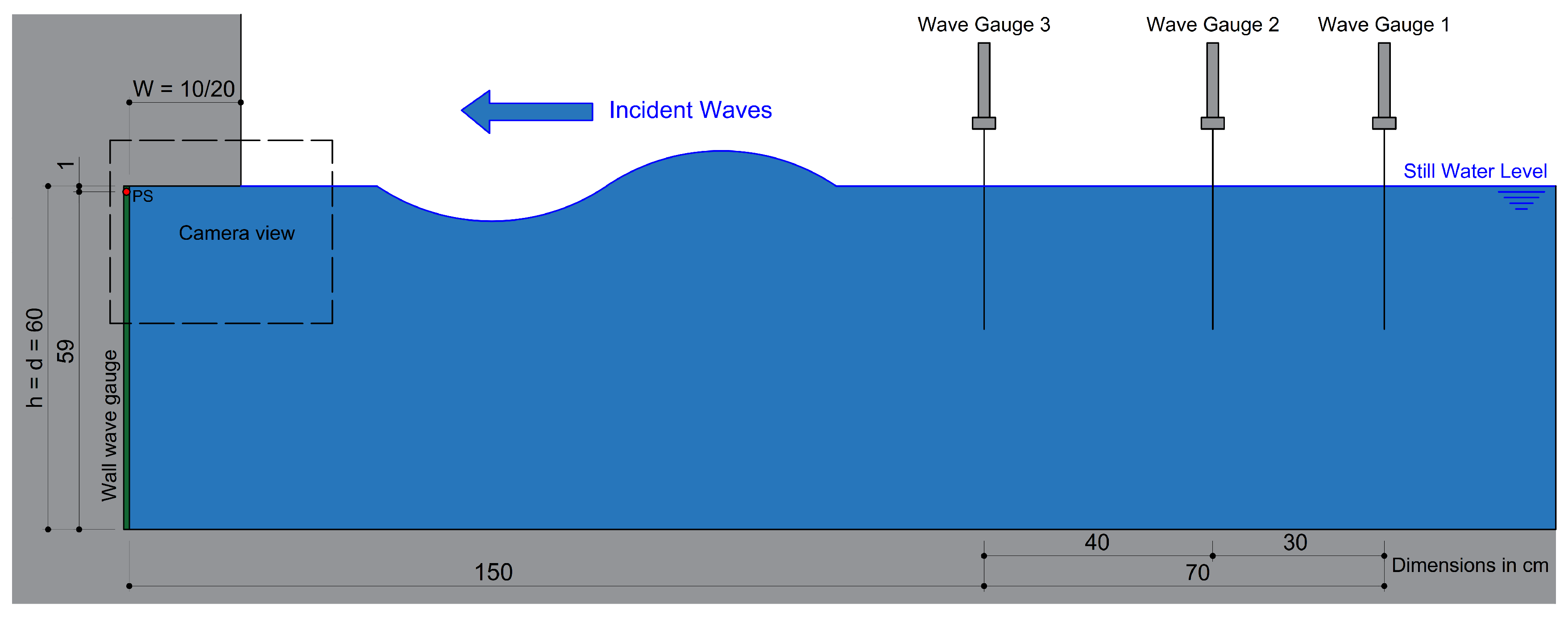
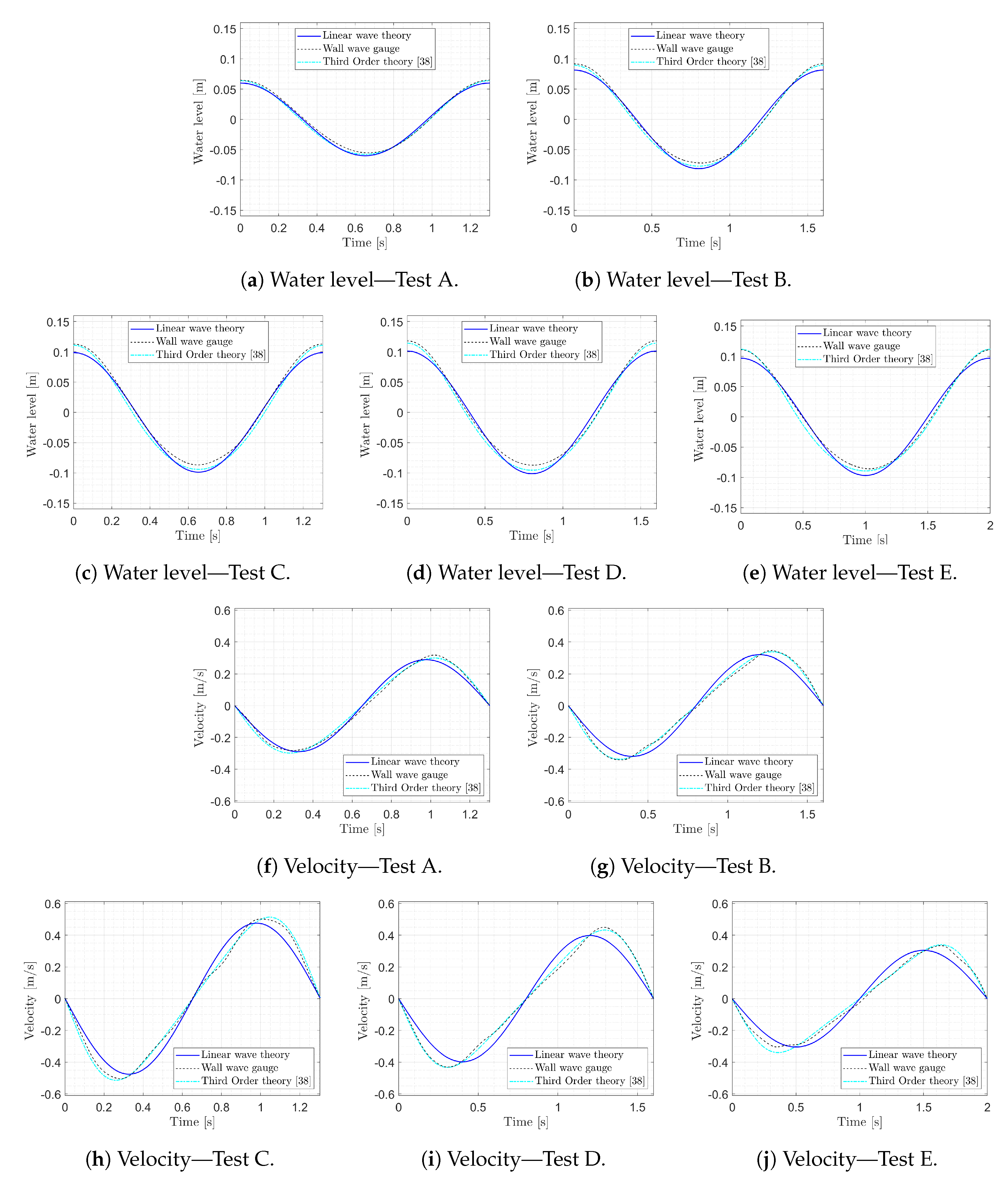
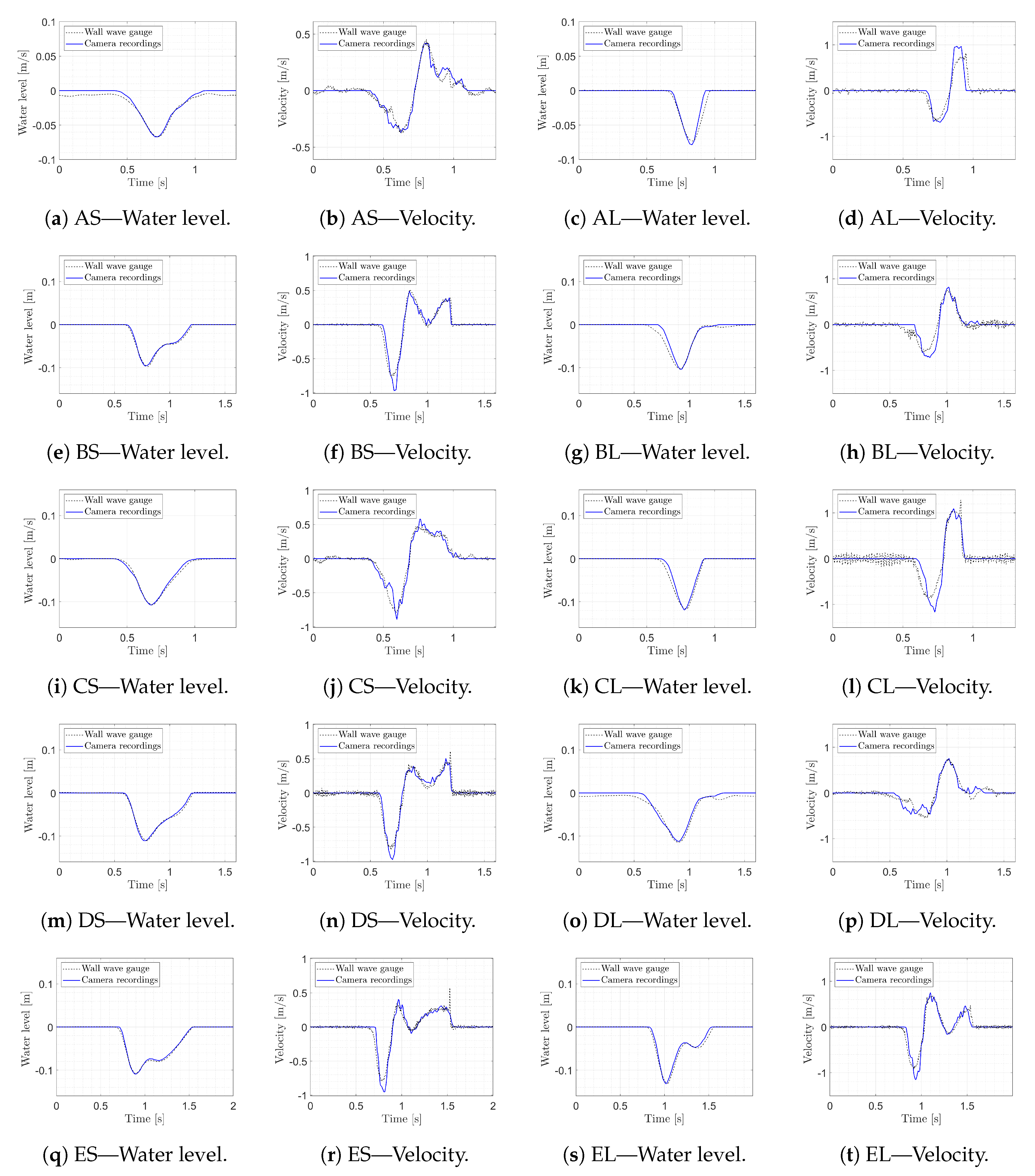
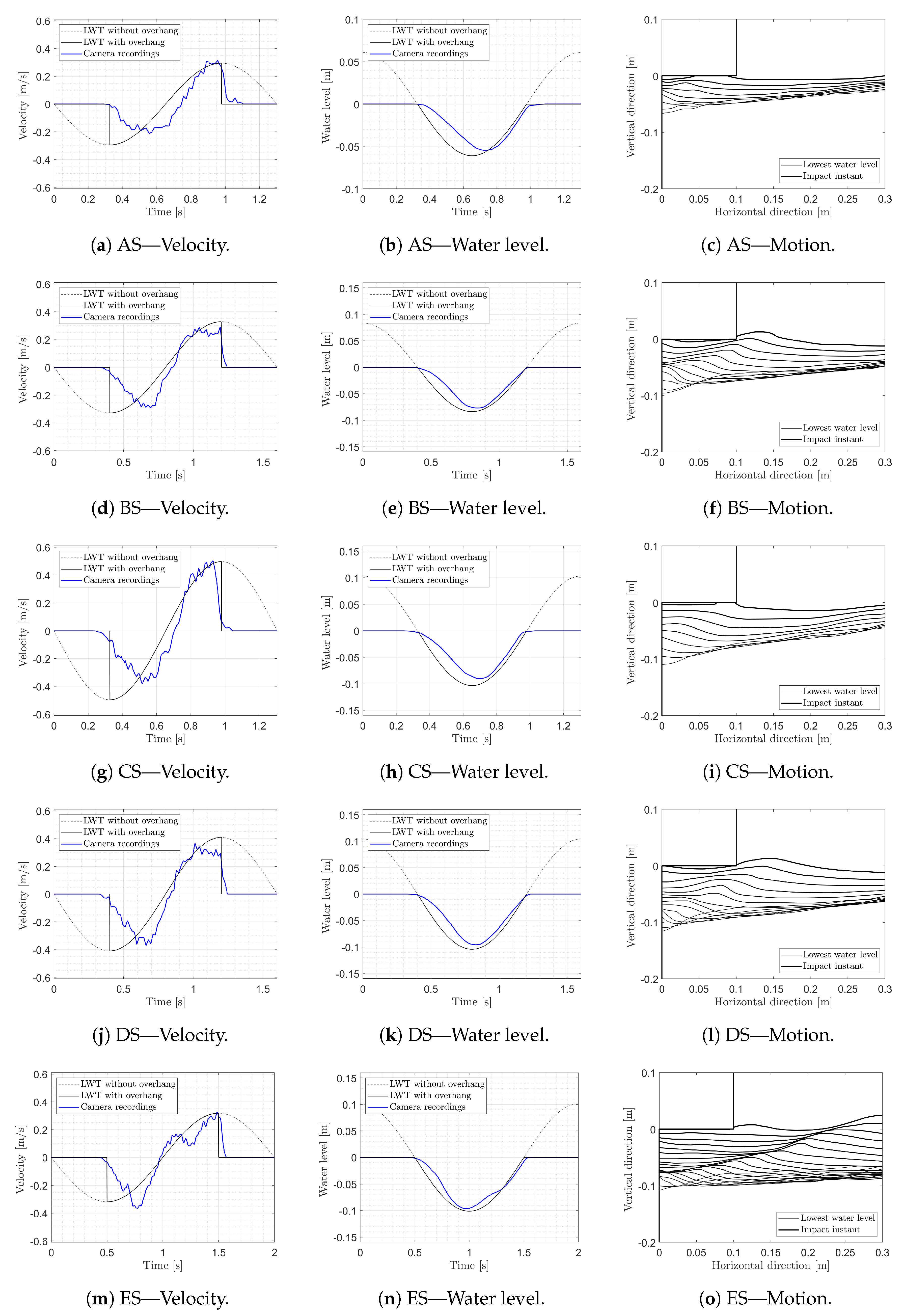
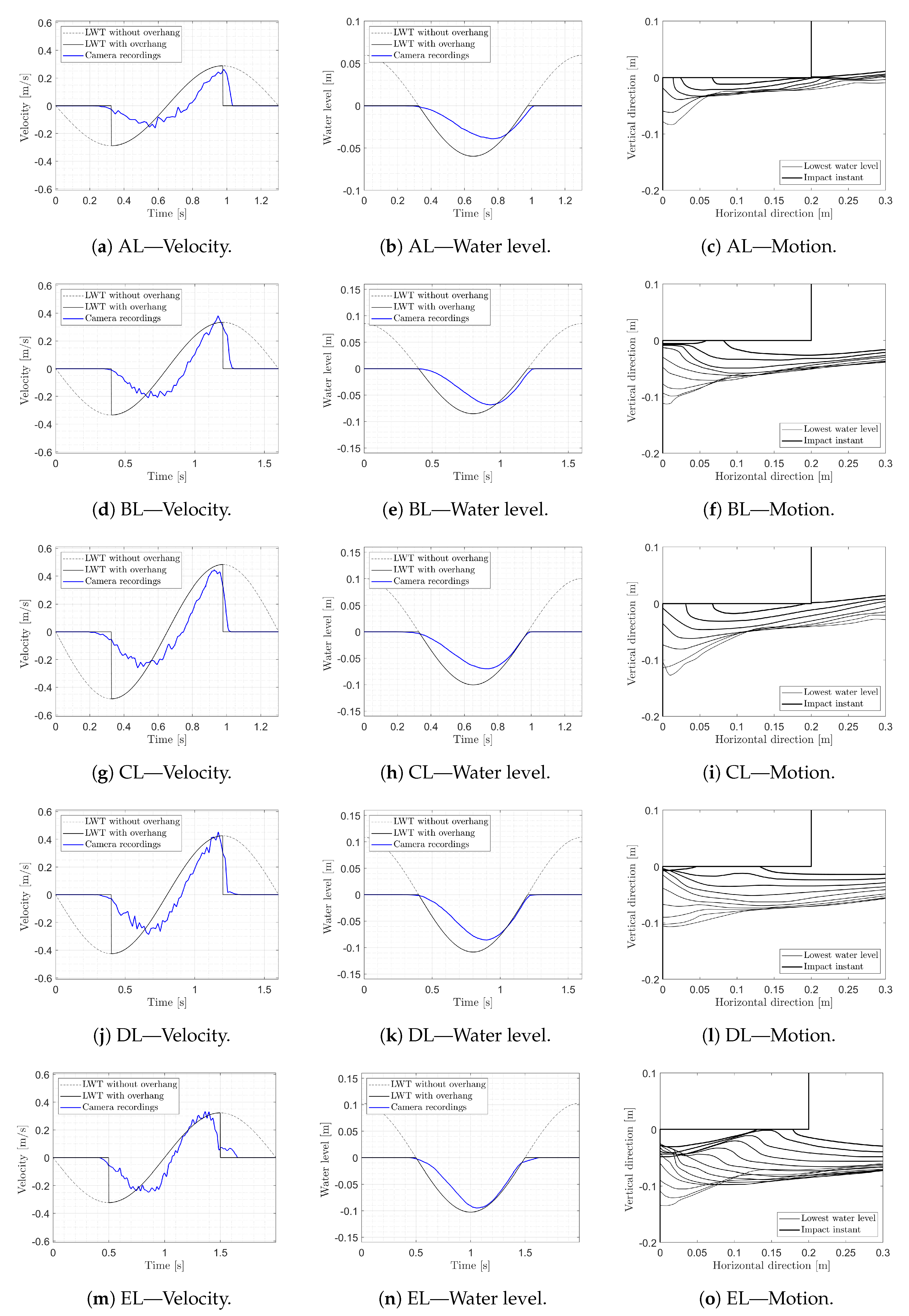
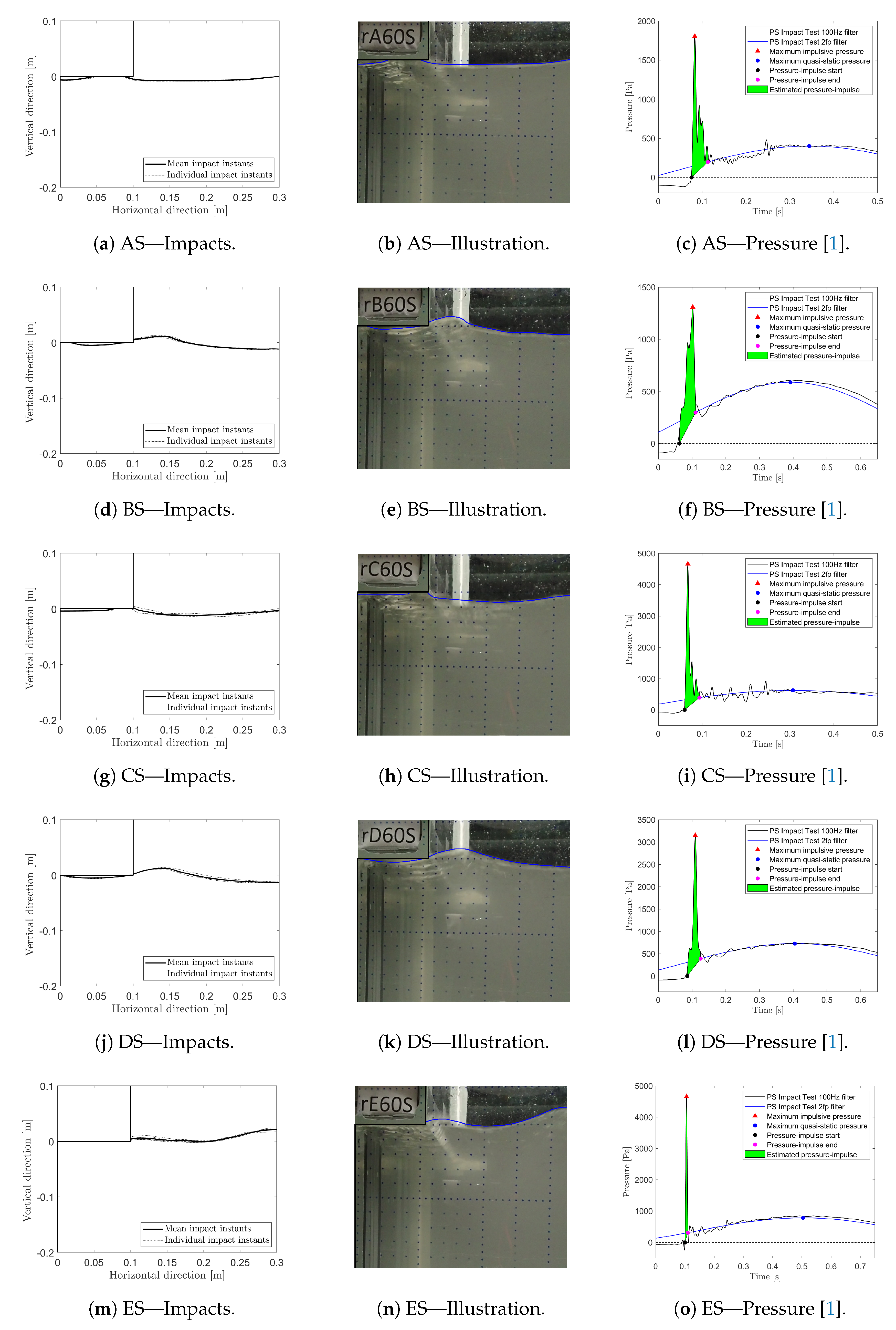
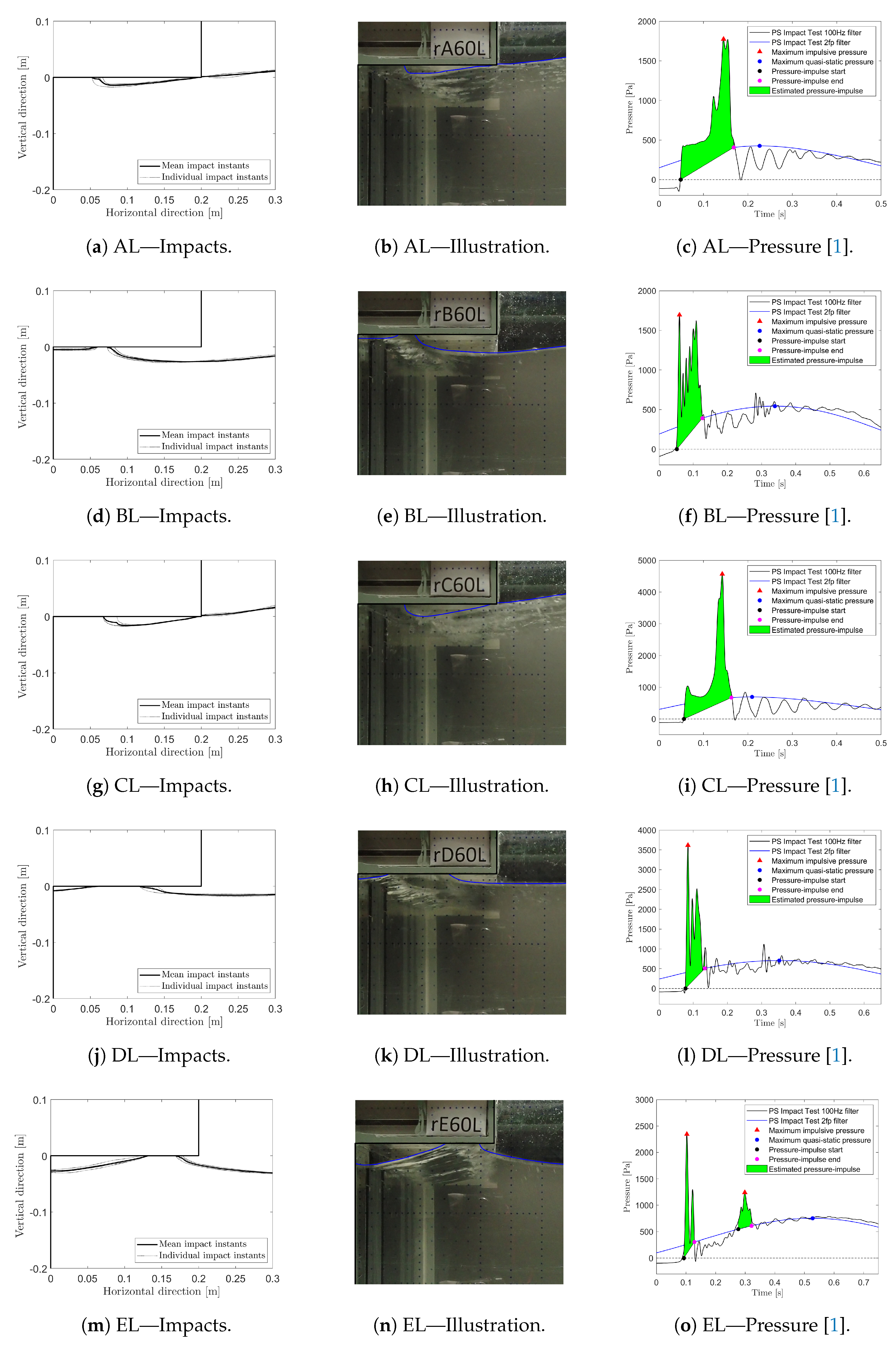

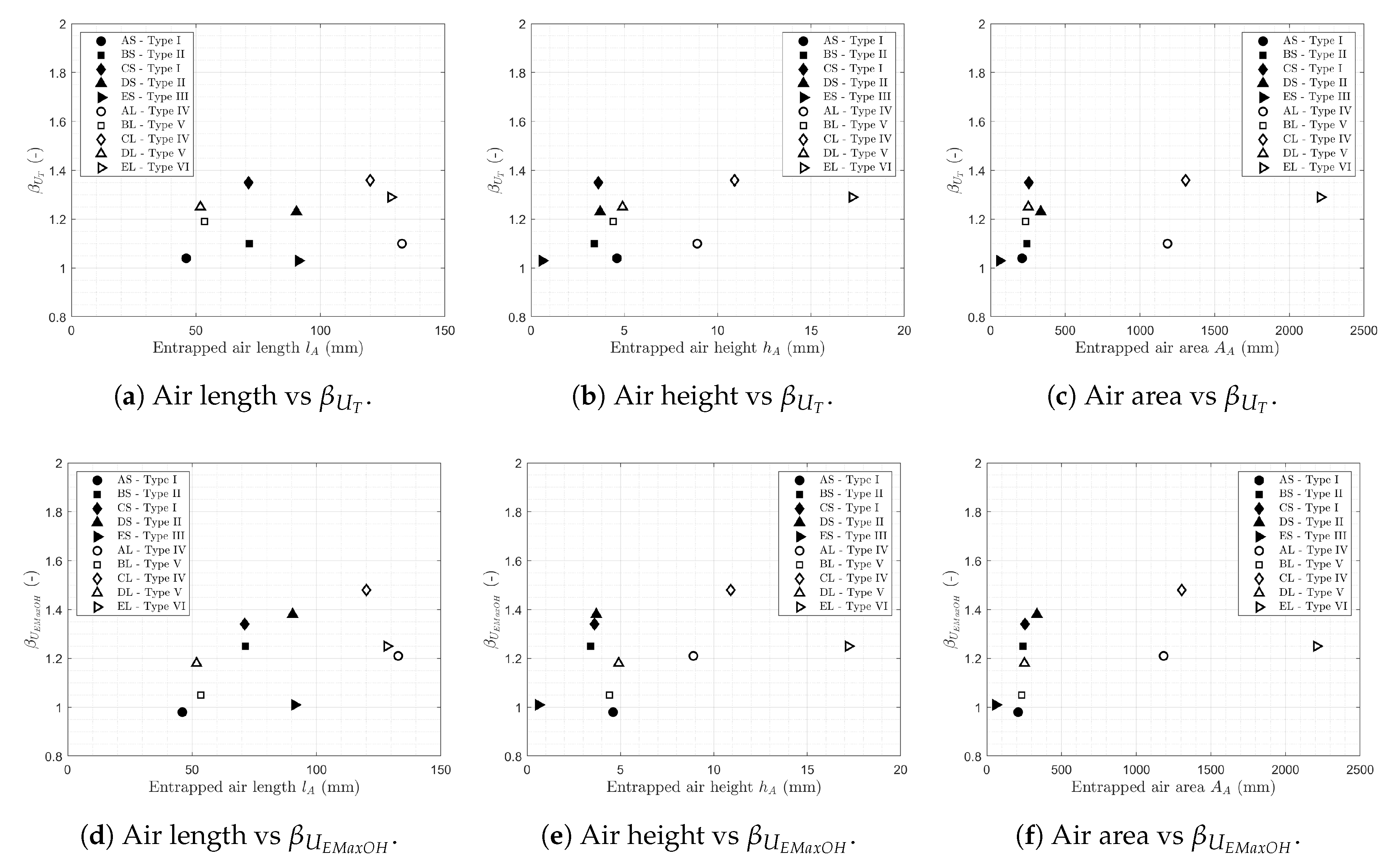
| Test | W [m] | h [m] | d [m] | H [m] | [%] | T [s] | L [m] | s [-] | [-] | [-] | Impact Type [-] |
|---|---|---|---|---|---|---|---|---|---|---|---|
| A | - | - | 0.6 | 0.060 | 3.3 | 1.30 | 2.42 | 0.025 | 0.98 | 1.6 | No impact |
| B | - | - | 0.6 | 0.081 | 1.7 | 1.60 | 3.27 | 0.025 | 0.99 | 4.0 | No impact |
| C | - | - | 0.6 | 0.099 | 3.1 | 1.30 | 2.43 | 0.041 | 0.98 | 2.7 | No impact |
| D | - | - | 0.6 | 0.101 | 2.3 | 1.60 | 3.27 | 0.031 | 0.99 | 5.0 | No impact |
| E | - | - | 0.6 | 0.097 | 0.5 | 2.00 | 4.36 | 0.022 | 0.99 | 8.5 | No impact |
| AS | 0.1 | 0.6 | 0.6 | 0.061 | 2.3 | 1.30 | 2.42 | 0.025 | 0.84 | 1.7 | Type I |
| BS | 0.1 | 0.6 | 0.6 | 0.084 | 1.8 | 1.60 | 3.27 | 0.026 | 0.93 | 4.1 | Type II |
| CS | 0.1 | 0.6 | 0.6 | 0.103 | 3.7 | 1.31 | 2.43 | 0.042 | 0.81 | 2.8 | Type I |
| DS | 0.1 | 0.6 | 0.6 | 0.104 | 2.4 | 1.60 | 3.27 | 0.032 | 0.94 | 5.2 | Type II |
| ES | 0.1 | 0.6 | 0.6 | 0.101 | 0.4 | 2.00 | 4.36 | 0.023 | 0.92 | 8.9 | Type III |
| AL | 0.2 | 0.6 | 0.6 | 0.060 | 1.3 | 1.30 | 2.42 | 0.025 | 0.67 | 1.6 | Type IV |
| BL | 0.2 | 0.6 | 0.6 | 0.085 | 3.1 | 1.60 | 3.27 | 0.026 | 0.78 | 4.2 | Type V |
| CL | 0.2 | 0.6 | 0.6 | 0.100 | 2.0 | 1.30 | 2.43 | 0.041 | 0.63 | 2.7 | Type IV |
| DL | 0.2 | 0.6 | 0.6 | 0.108 | 3.5 | 1.60 | 3.27 | 0.033 | 0.74 | 5.4 | Type V |
| EL | 0.2 | 0.6 | 0.6 | 0.103 | 0.6 | 2.00 | 4.36 | 0.024 | 0.82 | 9.0 | Type VI |
| Test | [m/s] | [m/s] | to [%] | [m/s] | to [%] | [m/s] | to [%] |
|---|---|---|---|---|---|---|---|
| A | 0.290 | 0.316 | +9.2 | 0.310 | +7.0 | 0.295 | +1.8 |
| B | 0.319 | 0.345 | +8.0 | 0.332 | +3.8 | 0.329 | +3.0 |
| C | 0.475 | 0.502 | +5.5 | 0.499 | +4.9 | 0.498 | +4.7 |
| D | 0.397 | 0.449 | +13.0 | 0.423 | +6.5 | 0.416 | +4.6 |
| E | 0.304 | 0.334 | +9.9 | 0.310 | +1.9 | 0.317 | +4.2 |
| Condition | [m/s] | [m/s] | to [%] | [-] | [-] |
|---|---|---|---|---|---|
| AS | 0.294 | 0.313 | +6.6 | 1.04 | 0.98 |
| BS | 0.328 | 0.289 | −11.8 | 1.10 | 1.25 |
| CS | 0.497 | 0.502 | +1.1 | 1.35 | 1.34 |
| DS | 0.409 | 0.365 | −10.8 | 1.23 | 1.38 |
| ES | 0.318 | 0.326 | +2.4 | 1.03 | 1.01 |
| AL | 0.288 | 0.261 | −9.3 | 1.10 | 1.21 |
| BL | 0.335 | 0.379 | +13.4 | 1.19 | 1.05 |
| CL | 0.483 | 0.445 | −8.0 | 1.36 | 1.48 |
| DL | 0.426 | 0.451 | +6.1 | 1.25 | 1.18 |
| EL | 0.323 | 0.333 | +3.1 | 1.29 | 1.25 |
| Test | [mm] | [%] | [mm] | [%] | [mm] | [%] | [ms] |
|---|---|---|---|---|---|---|---|
| AS | 46.1 | 6.6 | 4.6 | 8.3 | 210.0 | 9.6 | 37 |
| BS | 71.4 | 6.4 | 3.4 | 12.9 | 242.4 | 7.6 | 52 |
| CS | 71.1 | 3.4 | 3.6 | 7.5 | 255.7 | 10.5 | 36 |
| DS | 90.4 | 5.0 | 3.7 | 12.5 | 335.5 | 9.1 | 42 |
| ES | 91.2 | 9.6 | 0.6 | 22.4 | 59.2 | 14.0 | 10 |
| AL | 132.8 | 2.8 | 8.9 | 14.5 | 1184.0 | 16.5 | 110 |
| BL | 53.5 | 11.3 | 4.4 | 24.3 | 233.3 | 32.6 | 69 |
| CL | 120.1 | 9.2 | 10.9 | 6.5 | 1304.8 | 15.3 | 101 |
| DL | 51.8 | 16.0 | 4.9 | 12.1 | 252.0 | 10.0 | 57 |
| EL | 128.3 | 3.4 | 17.2 | 12.5 | 2207.6 | 15.1 | 37 |
Publisher’s Note: MDPI stays neutral with regard to jurisdictional claims in published maps and institutional affiliations. |
© 2020 by the authors. Licensee MDPI, Basel, Switzerland. This article is an open access article distributed under the terms and conditions of the Creative Commons Attribution (CC BY) license (http://creativecommons.org/licenses/by/4.0/).
Share and Cite
de Almeida, E.; Hofland, B. Experimental Observations on Impact Velocity and Entrapped Air for Standing Wave Impacts on Vertical Hydraulic Structures with Overhangs. J. Mar. Sci. Eng. 2020, 8, 857. https://doi.org/10.3390/jmse8110857
de Almeida E, Hofland B. Experimental Observations on Impact Velocity and Entrapped Air for Standing Wave Impacts on Vertical Hydraulic Structures with Overhangs. Journal of Marine Science and Engineering. 2020; 8(11):857. https://doi.org/10.3390/jmse8110857
Chicago/Turabian Stylede Almeida, Ermano, and Bas Hofland. 2020. "Experimental Observations on Impact Velocity and Entrapped Air for Standing Wave Impacts on Vertical Hydraulic Structures with Overhangs" Journal of Marine Science and Engineering 8, no. 11: 857. https://doi.org/10.3390/jmse8110857
APA Stylede Almeida, E., & Hofland, B. (2020). Experimental Observations on Impact Velocity and Entrapped Air for Standing Wave Impacts on Vertical Hydraulic Structures with Overhangs. Journal of Marine Science and Engineering, 8(11), 857. https://doi.org/10.3390/jmse8110857






